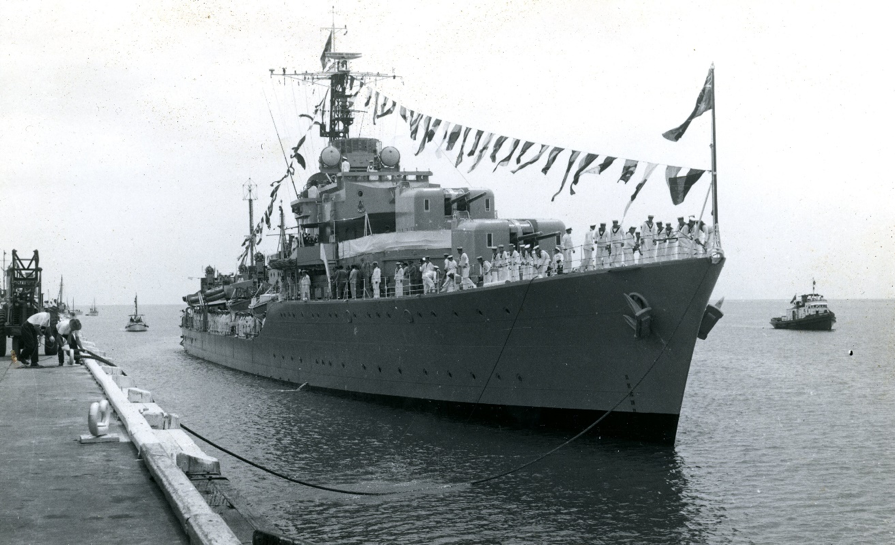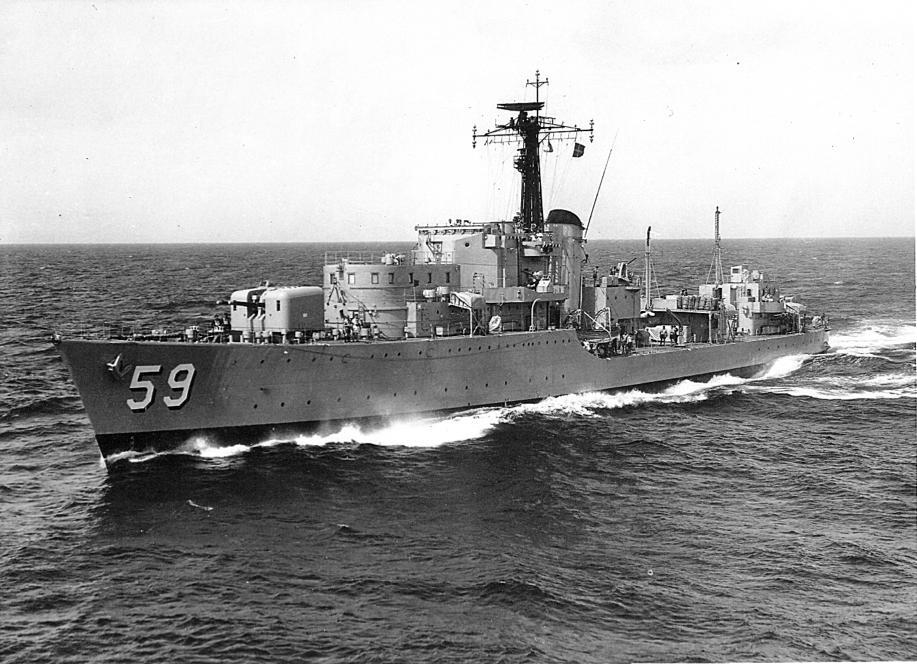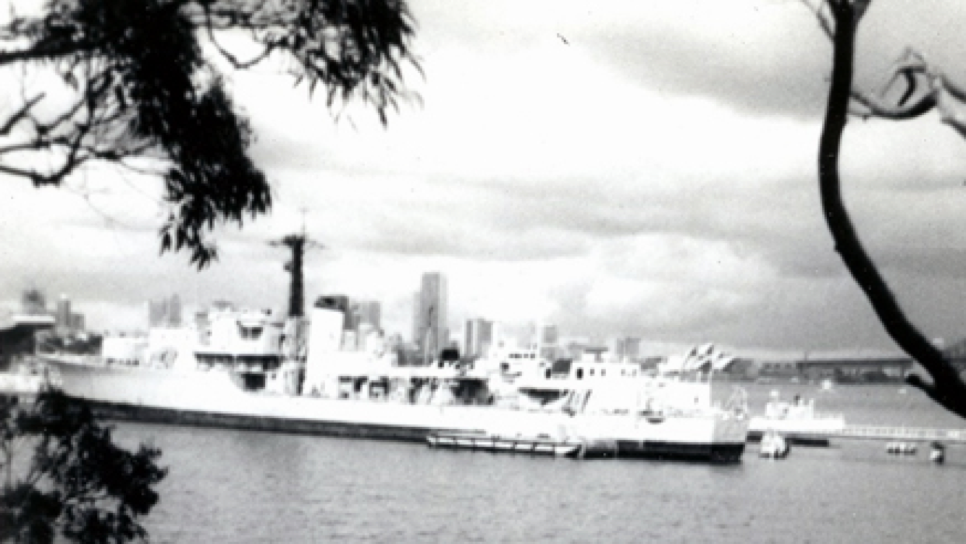March 2019
The following paper on the distinguished service of HMAS Anzac (II) was first published in the March 2011 edition of the Naval Historical Review available on the Society website. Other ships with her name are; HMAS Anzac (I), acquired from the Royal Navy, commissioned into the RAN in 1920 and decommissioned 30 July 1931. HMAS Anzac (III), lead ship of eight Anzac class frigates commissioned 18 May 1996.
HMAS Anzac (II) – the last ‘Battle’
With the end of World War II in sight the RAN had to plan for replacement ships of its hard worked destroyer force. The remaining ‘V&W’ destroyers HMA Ships Vendetta and Stuart were obsolete and worn out. The effective ‘N’ class had been returned to the Royal Navy and their replacement ‘Q’ class were inadequate for post-war requirements. In keeping with tradition of using Admiralty designs, the Naval Board considered the RN ‘Battle’ class destroyers as suitable replacements, and government approval was forthcoming to build two ships modified to RAN standards. One ship was to be built at Williamstown Naval Dockyard and the other at Cockatoo Island Dockyard.
Originally the names of these ships were intended to commemorate recent World War II Australian naval actions with the names ‘Tobruk’ and ‘Matapan’ selected. While the former name was retained, a decision was made to rescind the second in favour of ‘Anzac’.
‘Battle’ Class Destroyers
The ‘Battle’ class destroyers were built in Britain in two groups. Group 1 of sixteen ships commenced construction in 1942, with Group 2 of eight ships laid down from 1943. A further Group 3 of eight ships was intended in 1944 but with the end of World War II in sight the Admiralty cancelled these orders. However,
two ships of Group 3 were built by the RAN. Two of the RN ships were subsequently transferred to other navies, one to Pakistan and another to Iran.
The 1942 ‘Battles’ were a new class of Fleet Destroyers designed to operate within a Fleet environment and provide anti-submarine and anti-aircraft support. The original armament comprised two twin 4.5 inch Mark IV turrets; four twin 40mm Hazemeyer Bofors (one on each bridge wing and two on the centreline aft); one single 4 inch Mark XXIII (Starshell) gun; and two single 2 pounder pom poms Mark XV or Mark XVI. There were two sets of pentad (5) torpedo tubes as well as depth charge throwers. The depth charges were later removed when the SQUID ahead-throwing mortar was developed. The mortar was sited on the quarterdeck and fired its charges over and ahead of the ship, thereby maintaining improved contact with underwater targets. In earlier versions of the ‘Battles’ the single Bofor mounting on the quarterdeck had to be removed to make way for SQUID.
Construction in Australia
Anzac and her sister HMAS Tobruk were the first major warships constructed in Australia after World War II, and at that time the largest destroyers and most complicated fighting ships ever constructed in this country. Local modifications included upgrading the main armament to two twin Mark VI turrets as opposed to the Mark IV DP (Dual Purpose) turrets fitted in the RN ships, and the gunnery control system was upgraded from Flyplane Mk 1 to Flyplane Mk II, noting that the RAN ships were the only ships with this system, as later ships had the much improved Flyplane Mk III. Improvements were also made to habitability, with better ventilation and higher standards of accommodation.
Anzac was laid down at Williamstown Naval Dockyard on 23 September 1946 and was launched on 20 August 1948 by Mrs Collins, wife of the First Naval Member Rear Admiral J.A. Collins, RAN. She commissioned on 14 March 1951 under Commander J. Plunkett-Cole, RAN, who was also appointed Commander of the 10th Destroyer Flotilla. In the same timeframe her sister ship Tobruk was being built at Cockatoo Island Dockyard.

Korea
After workup Anzac joined the United Nations Forces in Korea in August 1951. On arrival in Korean waters she teamed up with Tobruk and the ‘River’ class frigate HMAS Murchison. Her first operation on 6 September was a bombardment of Haeju on the west coast, north of the 38th Parallel. Targets included a two storey building believed to house the headquarters of local North Korean forces, as well as a gun emplacement. The shore facilities were left a smoking ruin with many casualties.
Her next patrol was carried out on the east coast off Songjin, just south of the Korean-Chinese border. The mission to harass rail and road traffic was successful, with direct hits on at least one train. She was also involved in guerrilla style operations, landing South Korean Marines to gather intelligence.
After steaming some 23,000 nautical miles on operations in Korean waters, Anzac returned to Sydney in October 1951, having escorted the light fleet carrier HMS Glory to Sydney for refit.
In May 1952, now under command of Captain G.G.O. Gatacre, RAN, Anzac cruised with HMAS Australia (II) to New Guinea and the Solomons. In September she left for a second tour in Korea, relieving HMAS Bataan and serving with units of the USN, maintaining blockades of the enemy coast and bombarding enemy positions. She was shelled off the west coast on 16 November 1952 but Australia Day 1953 saw her shelling the battery position which had shelled her. On another occasion she was called to come to the aid of HMAS Condamine, which had come under fire whilst supporting minesweeping operations. The severe Korean winter posed great difficulties, with the ship and equipment coated in ice and snow.
In April 1953 Captain J.S. Mesley, DSC, RAN, relieved Captain Gatacre in command. On 26 May Anzac steamed into Tokyo, representing Commonwealth Navies during celebrations of the coronation of Queen Elizabeth II. After returning to the war zone Anzac was relieved by Tobruk in July. She returned to Sydney, having logged 57,000 nautical miles during her tour of duty, which included 140 days in the combat area.

Refit
Following a refit at Williamstown and now under command of Commander D.A.H. Clarke, DSC, RAN, Anzac escorted the Royal Yacht Gothic during the royal tour of Australia in February 1954. Anzac then conveyed Her Majesty and the Duke of Edinburgh to islands of the Great Barrier Reef.
Malayan Emergency
In April 1955 Anzac visited New Caledonia prior to engaging in Commonwealth Fleet exercises in South East Asia. During this period she had a succession of commanding officers including Commanders MacDonald, Crabb and Peel. From November 1955, for several deployments up till March 1959, Anzac was attached to the Commonwealth Strategic Reserve based at Singapore. In September 1956, in company with Tobruk, she took part in the first of only two offensive actions taken by the RAN during the Malayan Emergency (1948-1960) when they bombarded terrorist positions in Johore State.
Varied responsibilities
During gunnery exercises off Jervis Bay in September 1960 a misdirected shot from Anzac badly damaged Tobruk. The cause of the accident was neglecting to correctly apply six degrees of ‘throw-off’; as a result Anzac’s guns, while near maximum range, were directly facing Tobruk. Whilst there were no casualties, Tobruk’s engine room was flooded and her main machinery damaged. She limped into Jervis Bay for emergency repairs and then to Sydney for more extensive repairs but Tobruk saw little sea service after this.
In 1961 Anzac became the Fleet Training Ship with the gradual removal of armament in favour of additional accommodation. The process continued in 1963 when she was further modified with ‘B’ turret and torpedo tubes removed and replaced by classrooms. This once handsome ship was to become rather ungainly in later years.

In February/March 1963, during the royal visit to Australia, Anzac again acted as escort to HMS Britannia.
In October/November 1966 she under-took survey work off the north of Western Australia, and in June 1967 visited Tonga for the coronation of His Majesty King Taufa’Ahau Tupo IV.
In September 1967 Anzac conducted a South Pacific training cruise visiting Tahiti, Western Samoa and New Zealand. Following refit, and although a training ship, Anzac escorted the troop carrier HMAS Sydney to Vietnam in June 1968.
During 1970 she participated in the Captain Cook celebrations at Possession Island, Queensland, the site of Captain Cook’s final departure from Australian shores. In March 1972 Anzac acted as command ship during exercise ‘Planti Manua’, a large patrol boat exercise held in northern waters involving ten patrol vessels. New Zealand was again visited during a training cruise in September 1972.
Paid off
In 1974 Anzac departed for her final training cruise to Fiji and New Zealand and returned to Sydney on 11 August of that year flying her paying-off pendant.
After twenty-three years of eventful service Anzac was taken out of commission in October 1974 and removed to Athol Bight. This ship, which had fired in anger in both Korea and Malaya, slipped almost unnoticed out of Sydney on New Year’s Eve 1975, under the tow of a Japanese tug on her way to be scrapped in China.





